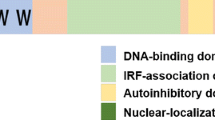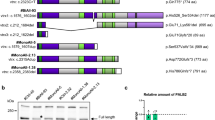Abstract
Nuclear factor of κB (NF-κB) is a group of sequence-specific transcription factors that is best known as a key regulator of the inflammatory and innate immune responses. Recent studies of genetically engineered mice have clearly indicated that NF-κB is also required for proper organogenesis of several epithelial tissues, including the mammary gland. Mice have shown severe lactation deficiency when NF-κB activation is specifically blocked in the mammary gland. In addition, there are strong suggestions that NF-κB may play an important role in the etiology of breast cancer. Elevated NF-κB DNA-binding activity is detected in both mammary carcinoma cell lines and primary human breast cancer tissues.
Similar content being viewed by others
REFERENCES
S. Ghosh and M. Karin (2002). Missing pieces in the NF-κB puzzle. Cell 109(Suppl):S81-S96.
M. Karin and A. Lin (2002). NF-κB at the crossroads of life and death. Nat. Immunol. 3:221–227.
D. M. Rothwarf and M. Karin (1999). The NF-κB activation pathway: A paradigm in information transfer from membrane to nucleus. Sci. STKE 1999:RE1.
M. J. May and S. Ghosh (1997). Rel/NF-κB and IκB proteins: An overview. Semin. Cancer Biol. 8:63–73.
I. Verma, J. Stevenson, E. Schwarz, D. Van Antwerp, and S. Miyamoto (1995). Rel/NF-κB/IκB family: Intimate tales of association and dissociation. Genes Dev. 9:2723–2735.
M. Karin and Y. Ben-Neriah (2000). Phosphorylation meets ubiquitination: The control of NF-[κ]B activity. Annu. Rev. Immunol. 18:621–663.
E. Dejardin, N. M. Droin, M. Delhase, E. Haas, Y. Cao, C. Makris, et al. (2002). The lymphotoxin-beta receptor induces different patterns of gene expression via two NF-κB pathways. Immunity 17: 525–535.
H. Pahl (1999). Activators and target genes of Rel/NF-κB transcription factors. Oncogene 18: 6853–6866.
M. Karin, Y. Cao, F. R. Greten, and Z. W. Li (2002). NF-κB in cancer: From innocent bystander to major culprit. Nature Rev. Cancer 2:301–310.
B. Rayet and C. Gelinas (1999). Aberrant rel/nfkb genes and activity in human cancer. Oncogene 18:6938–6947.
T. Gilmore, M. Koedood, K. Piffat, and D. White (1996). Rel/NF-κB/IκB proteins and cancer. Oncogene 13: 1367–1378.
L. Hennighausen and G. W. Robinson (2001). Signaling pathways in mammary gland development. Dev. Cell 1:467–475.
L. Hennighausen and G. W. Robinson (1998). Think globally, act locally: The making of a mouse mammary gland. Genes Dev. 12: 449–455.
D. M. Brantley, F. E. Yull, R. S. Muraoka, D. J. Hicks, C. M. Cook, and L. D. Kerr (2000). Dynamic expression and activity of NF-κB during post-natal mammary gland morphogenesis. Mech. Dev. 97:149–155.
R. W. Clarkson, J. L. Heeley, R. Chapman, F. Aillet, R. T. Hay, A. Wyllie, et al. (2000). NF-κB inhibits apoptosis in murine mammary epithelia. J. Biol. Chem. 275: 12737–12742.
S. Geymayer and W. Doppler (2000). Activation of NF-κB p50/p65 is regulated in the developing mammary gland and inhibits STAT5-mediated beta-casein gene expression. FASEB J. 14:1159–1170.
D. M. Brantley, C. L. Chen, R. S. Muraoka, P. B. Bushdid, J. L. Bradberry, F. Kittrell, et al. (2001). Nuclear factor-κB (NF-κB) regulates proliferation and branching in mouse mammary epithelium. Mol. Biol. Cell 12:1445–1455.
Y. Cao, G. Bonizzi, T. N. Seagroves, F. R. Greten, R. Johnson, E. V. Schmidt, et al. (2001). IKKalpha provides an essential link between RANK signaling and cyclin D1 expression during mammary gland development. Cell 107: 763–775.
J. M. Shillingford, K. Miyoshi, G. W. Robinson, B. Bierie, Y. Cao, M. Karin, et al. (2003). Proteotyping of mammary tissue from transgenic and gene knockout mice with immunohistochemical markers. A tool to define developmental lesions. J. Histochem. Cytochem. 51: 555–565.
G. Luo and L. Yu-Lee (2000). Stat5b inhibits NF-kB-mediated signaling. Mol. Endocrinol. 14: 114–123.
Y. Wang, T. R. Wu, S. Cai, T. Welte, and Y. E. Chin (2000). Stat1 as a component of tumor necrosis factor alpha receptor 1-TRADD signaling complex to inhibit NF-κB activation. Mol. Cell. Biol. 20: 4505–4512.
R. W. Clarkson and C. J. Watson (1999). NF-κB and apoptosis in mammary epithelial cells. J. Mammary Gland Biol. Neoplasia 4:165–175.
L. E. Theill, W. J. Boyle, and J. M. Penninger (2002). RANK-L and RANK: T cells, bone loss, and mammalian evolution. Annu. Rev. Immunol. 20:795–823.
J. E. Fata, Y. Y. Kong, J. Li, T. Sasaki, J. Irie-Sasaki, R. A. Moorehead, et al. (2000). The osteoclast differentiation factor osteoprotegerin-ligand is essential for mammary gland development. Cell 103:41–50.
L. Varela and M. Ip (1996). Tumor necrosis factor-alpha:A multifunctional regulator of mammary gland development. Endocrinology 137:4915–4924.
P. Sicinski, J. L. Donaher, S. B. Parker, T. Li, A. Fazeli, H. Gardner, et al. (1995). Cyclin D1 provides a link between development and oncogenesis in the retina and breast. Cell 82:621–630.
V. Fantl, G. Stamp, A. Andrews, I. Rosewell, and C. Dickson (1995). Mice lacking cyclin D1 are small and show defects in eye and mammary gland development. Genes Dev. 9:2364–2372.
O. N. Ozes, L. D. Mayo, J. A. Gustin, S. R. Pfeffer, L. M. Pfeffer, and D. B. Donner (1999). NF-κB activation by tumour necrosis factor requires the Akt serine-threonine kinase. Nature 401:82–85.
J. A. Romashkova and S. S. Makarov (1999). NF-κB is a target of AKT in anti-apoptotic PDGF signalling. Nature 401:86–90.
K. L. Schwertfeger, M. M. Richert, and S. M. Anderson (2001). Mammary gland involution is delayed by activated Akt in transgenic mice. Mol. Endocrinol. 15:867–881.
J. Hutchinson, J. Jin, R. D. Cardiff, J. R. Woodgett, and W. J. Muller (2001). Activation of Akt (protein kinase B) in mammary epithelium provides a critical cell survival signal required for tumor progression. Mol. Cell. Biol. 21:2203–2212.
S. Gerondakis, M. Grossmann, Y. Nakamura, T. Pohl, and R. Grumont (1999). Genetic approaches in mice to understand Rel/NF-kB and IkB functions: Transgenics and knockouts. Oncogene 18:6888–6895.
A. A. Beg, W. C. Sha, R. T. Bronson, S. Ghosh, and D. Baltimore (1995). Embryonic lethality and liver degeneration in mice lacking the RelA component of NF-κB. Nature 376:167–170.
Z. W. Li, W. Chu, Y. Hu, M. Delhase, T. Deerinck, M. Ellisman, et al. (1999). The IKKbeta subunit of IκB kinase (IKK) is essential for nuclear factor κB activation and prevention of apoptosis. J. Exp. Med. 189:1839–1845.
C. Makris, V. L. Godfrey, G. Krahn-Senftleben, T. Takahashi, J. L. Roberts, T. Schwarz, et al. (2000). Female mice heterozygous for IKK gamma/NEMO deficiencies develop a dermatopathy similar to the human X-linked disorder incontinentia pigmenti. Mol. Cell 5:969–979.
P. C. Cogswell, D. C. Guttridge, W. K. Funkhouser, and A. S. BaldwinJr. (2000). Selective activation of NF-κB subunits in human breast cancer: Potential roles for NF-κB2/p52 and for Bcl-3. Oncogene 19:1123–1131.
H. Nakshatri, P. Bhat-Nakshatri, D. A. Martin, R. J. GouletJr., and G. W. SledgeJr. (1997). Constitutive activation of NF-κB during progression of breast cancer to hormone-independent growth. Mol. Cell. Biol. 17:3629–3639.
M. A. Sovak, R. E. Bellas, D. W. Kim, G. J. Zanieski, A. E. Rogers, A. M. Traish, et al. (1997). Aberrant nuclear factor-κB/Rel expression and the pathogenesis of breast cancer. J. Clin. Invest. 100:2952–2960.
R. Romieu-Mourez, E. Landesman-Bollag, D. C. Seldin, A. M. Traish, F. Mercurio, and G. E. Sonenshein (2001). Roles of IKK kinases and protein kinase CK2 in activation of nuclear factor-κB in breast cancer. Cancer Res. 61:3810–3818.
D. W. Kim, M. A. Sovak, G. Zanieski, G. Nonet, R. Romieu-Mourez, A. W. Lau, et al. (2000). Activation of NF-κB/Rel occurs early during neoplastic transformation of mammary cells. Carcinogenesis 21:871–879.
D. K. Biswas, S. C. Dai, A. Cruz, B. Weiser, E. Graner, and A. B. Pardee (2001). The nuclear factor κB (NF-κB): A potential therapeutic target for estrogen receptor negative breast cancers. Proc. Natl. Acad. Sci. U.S.A. 98:10386–10391.
M. A. Sovak, M. Arsura, G. Zanieski, K. T. Kavanagh, and G. E. Sonenshein (1999). The inhibitory effects of transforming growth factor beta1 on breast cancer cell proliferation are mediated through regulation of aberrant nuclear factor-κB/Rel expression. Cell Growth Differ. 10:537–544.
E. Dejardin, G. Bonizzi, A. Bellahcene, V. Castronovo, M. P. Merville, and V. Bours (1995). Highly-expressed p100/p52 (NFKB2) sequesters other NF-κB-related proteins in the cytoplasm of human breast cancer cells. Oncogene 11:1835–1841.
S. D. Westerheide, M. W. Mayo, V. Anest, J. L. Hanson, and A. S. BaldwinJr. (2001). The putative oncopretein Bcl-3 induces cyclin D1 to stimulate G1 transition. Mol. Cell. Biol. 21:8428–8436.
N. J. Solan, H. Miyoshi, G. D. Bren, and C. V. Paya (2002). RelB cellular regulation and transcriptional activity are regulated by p100. J. Biol. Chem. 277:1405–1418.
D. W. Kim, L. Gazourian, S. A. Quadri, R. Romieu-Mourez, D. H. Sherr, and G. E. Sonenshein (2000). The RelA NF-κB subunit and the aryl hydrocarbon receptor (AhR) cooperate to transactivate the c-myc promoter in mammary cells. Oncogene 19:5498–5506.
E. L. Lagow and D. D. Carson (2002). Synergistic stimulation of MUC1 expression in normal breast epithelial and breast cancer cells by interferon-gamma and tumor necrosis factor-alpha. J. Cell Biochem 86:759–772.
V. Deregowski, S. Delhalle, V. Benoit, V. Bours, and M. P. Merville (2002). Identification of cytokine-induced nuclear factor-κB target genes in ovarian and breast cancer cells. Biochem. Pharmacol. 64:873–881.
T. S. Finco, J. K. Westwick, J. L. Norris, A. A. Beg, C. J. Der, and A. S. Baldwin Jr. (1997). Oncogenic Ha-Ras-induced signaling activates NF-κB transcriptional activity, which is required for cellular transformation. J. Biol. Chem. 272:24113–24116.
H. Jo, R. Zhang, H. Zhang, T. A. McKinsey, J. Shao, R. D. Beauchamp, et al. (2000). NF-κB is required for H-ras oncogene induced abnormal cell proliferation and tumorigenesis. Oncogene 19:841–849.
S. Pianetti, M. Arsura, R. Romieu-Mourez, R. J. Coffey, and G. E. Sonenshein (2001). Her-2/neu overexpression induces NF-κB via a PI3-kinase/Akt pathway involving calpain-mediated degradation of IκB-alpha that can be inhibited by the tumor suppressor PTEN. Oncogene 20:1287–1299.
B. P. Zhou, M. C. Hu, S. A. Miller, Z. Yu, W. Xia, S. Y. Lin, et al. (2000). HER-2/neu blocks tumor necrosis factor-induced apoptosis via the Akt/NF-κB pathway. J. Biol. Chem. 275:8027–8031.
L. T. Amundadottir and P. Leder (1998). Signal transduction pathways activated and required for mammary carcinogenesis in response to specific oncogenes. Oncogene 16:737–746.
P. Bhat-Nakshatri, C. J. Sweeney, and H. Nakshatri (2002). Identification of signal transduction pathways involved in constitutive NF-κB activation in breast cancer cells. Oncogene 21:2066–2078.
D. C. Guttridge, C. Albanese, J. Y. Reuther, R. G. Pestell, and A. S. BaldwinJr. (1999). NF-κB controls cell growth and differentiation through transcriptional regulation of cyclin D1. Mol. Cell. Biol. 19:5785–5799.
M. Hinz, D. Krappmann, A. Eichten, A. Heder, C. Scheidereit, and M. Strauss (1999). NF-κB function in growth control: Regulation of cyclin D1 expression and G0/G1-to-S-phase transition. Mol. Cell. Biol. 19:2690–2698.
T. C. Wang, R. D. Cardiff, L. Zukerberg, E. Lees, A. Arnold, and E. V. Schmidt (1994). Mammary hyperplasia and carcinoma in MMTV-cyclin D1 transgenic mice. Nature 369:669–671.
Q. Yu, Y. Geng, and P. Sicinski (2001). Specific protection against breast cancers by cyclin D1 ablation. Nature 411:1017–1021.
I. Eto (2000). Molecular cloning and sequence analysis of the promoter region of mouse cyclin D1 gene: implication in phorbol ester-induced tumour promotion. Cell Prolif. 33:167–187.
Author information
Authors and Affiliations
Rights and permissions
About this article
Cite this article
Cao, Y., Karin, M. NF-κB in Mammary Gland Development and Breast Cancer. J Mammary Gland Biol Neoplasia 8, 215–223 (2003). https://doi.org/10.1023/A:1025905008934
Issue Date:
DOI: https://doi.org/10.1023/A:1025905008934




